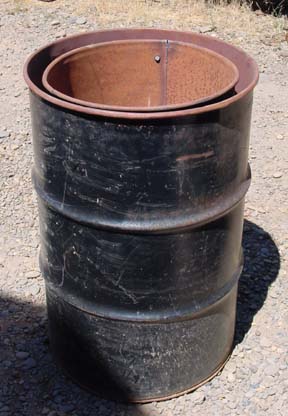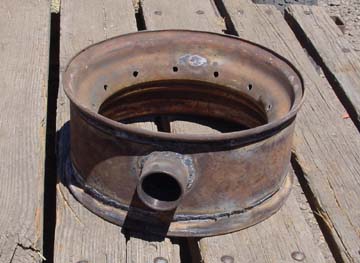
| << previous page | next page >> | |||||||||
Wood gas generator construction detailsalong with an overview of the reactions The design we're building is called a "down-draft generator," and construction-wise, it can be described as a tank within a tank within a tank. 
A key goal for this stage of the project is to incorporate as much "off the shelf," or more accurately "out of the scrap pile," materials as possible. There's nothing wrong with making components from scratch if you need to, but no design of this level of complexity is likely to give optimal performance in its original form, so the first goal is to get an initial unit up and working as quickly, and cheaply, as possible and then "kaizen" from there. [kaizen - achieving a perfection of design through small, incremental improvements] For an outside shell, we're using an open-top 55 gallon drum. Inside of that is another 55 gallon drum that's been cut down, compressed and fastened together to create an inner wall that's about two inches smaller in diameter than the outside drum. The interior of the generator is a heat exchanger in which the heat from the exhaust gas cooks off the pyrolytic gas from the wood chips. One design goal is to keep most of the heat within the generator driving the initial pyrolytic phase of the conversion process, instead of heating up the environment around the generator. In order to keep the reaction heat within the core of the gassifier, the space between the two drums will be filled with castable refractory insulation. 
[pyrolysis - to break down a compound by heating it in an anaerobic atmosphere.] [anaerobic - having to do with an oxygen free environment.] The innermost drum is a 40 gallon civil defense drum. This is the part of the tank that gets filled with wood chips. This tank forms the generator's "upper zone" - the place where the feed wood is pyrolysed. What you're seeing in the picture is a lid for a 55 gallon open-top drum that's had a round hole cut in it just the right size to take the 40 gallon inner drum. When complete, this internal reactor will be nestled down inside the insulated 55 gallon drum, and a standard drum clamp will provide the final seal. Pyrolytic gas is a hodgepodge of organic compounds including methane, methanol, ethane, ethanol, methyl ethyl ether and a host of tars and heavier compounds formed when the sugars, cellulose and lignins in the wood are broken down by heat. This gas will burn, but it is a low quality fuel that will quickly clog up your piping as the water and tars in the gas condense out. Very messy. Very unsatisfactory. Which is why there are two more operations happening within the generator: oxydation and reduction. The first stage of the process involves cooking off the wood to produce pyrolytic gas, a process which starts at about 451 °F, and is pretty much complete by around 800 °F. What you're left with is charcoal. Most of the wood gas automotive systems used during World War II used charcoal, instead of raw wood, so that they could skip the pyrolytic phase and minimize the size of the generator. Doing it all in one generator requires a larger, more sophisticated unit, and if you have room, then it's the way to go, and go farther, since you get more energy out of a pound of wood if you burn both the charcoal and the pyrolytic gases. By the time the wood works its way down to the bottom of the 40 gallon drum, it's been converted to charcoal; that's when things really start to heat up. The section of the generator immediately below the pyrolytic chamber is the oxydation hearth. This is where a portion of the charcoal is burned to generate the heat that drives the process.
Charcoal burns in air at between 2,000 °F and 3,000 °F, giving off carbon dioxide [C0 2 ] and carbon monoxide [CO] depending on how much oxygen is available. [air - a 20% active mixture of oxygen and inert gases. The key point here is that it takes energy to heat a gas from room temperature to combustion temperature. If you're using air as your oxygen source, you have to heat four pounds of inert gas (i.e. nitrogen) in order to "burn" a pound of oxygen. The woodgas generated will be diluted by the presence of the inert nitrogen, and have a correspondingly lower energy content than it would if pure oxygen was used as the oxydizer.] It's here in this middle zone, the hearth zone, that we'll generate the heat needed to drive the chemistry; the pyrolysis above, and then the reduction below. [endothermic - a chemical reaction that requires a continuous input of heat in order for it to proceed.] [exothermic - a chemical reaction that gives off heat as it proceeds.] For this initial model, I built the hearth out of mobile home tire rim. Turned out that the outer rim was just barely larger than the inner lip of the 40 gal CD drum. All it took to secure it in place was a few metal screws to keep it centered. As mentioned before, this wood gas generator is a downdraft design. Air isn't blown into the generator; rather, air is drawn down through the generator by the vacuum created by the vehicle's engine. Essentially, an internal combustion engine functions as a vacuum pump. As the pistons descend, they create a vacuum which in turn draws air and fuel into the cylinders through the engine's intake manifold. When running on wood gas, the engine draws the fuel gas, a mixture of H2, CO and inert N2 from the generator, into the intake manifold, and from there, into the engine. As the engine creates a vacuum in the generator, air and superheated steam are drawn into the hearth ring through a 2" coupling welded to the side of the hearth. That feeds into a distribution chamber created by welding a 5" strip of steel plate to the rim; this chamber distributes the air/steam mixture around the hearth ring. The hearth ring has a dozen 3/8" holes drilled into the lower portion of the chamber through which the incoming gas is sucked into the burning charcoal. At that point, the primary exothermic reaction is: 1) C + O2 => CO2 + Heat In addition, there are two exothermic secondary reactions happening: 2) 2 C + O2 => 2 CO + Heatthe partial oxidation of the glowing char, and 3) CXH2X + O2 => 2 CO + H2O + Heatthe partial oxidation of the pyrolytic gas. As noted above, each of the reactions happening in the oxidation zone give off lots of heat which turns the remaining charcoal into what's known as "glowing char." Next stop, the Reduction Zone - the place where the digester does it's magic.
To recap, raw wood was heated in the first, uppermost chamber to the point where the volatile pyrolytic gases were released, and the wood was converted to charcoal. In the second chamber, the hearth zone, air was introduced and part of the charcoal was burned, thereby releasing a lot of heat and converting the remaining charcoal into what's known as "glowing char." It's the glowing char that does the work in the reduction zone. As the glowing char falls through the hearth zone, it is captured in a stainless steel bowl; i.e. the reduction bowl. The bowl is made from a stainless steel mixing bowl that has lots of holes, sort of like a very coarse sieve, and is held in place under the hearth ring by the metal ring shown above the bowl. The ring was brazed to the bottom of the hearth, but the bowl just sits loose in the ring so that it can be mechanically shaken periodically in order to allow the ash to pass through and collect at the bottom of the It's when the gases are drawn through this bed of glowing carbon that the endothermic reactions take place: This reaction is known as the "water gas" reaction, and it was the primary way that gas was made for industrial and domestic use a century ago. Later, the construction of a web of pipelines made it possible to pipe "natural gas," a mixture of methane and carbon dioxide, around the country, and the water gas plants were shut down in favor of the cheaper energy source. Glowing char is so agressive that it strips the oxygen atom away from the water molecule leaving you with two combustible gases, carbon monoxide and hydrogen. These two gases are what will fuel the engine and move us down the road.
The same sort of thing happens to any oxygen-containing carbon compound produced during the pyrolytic stage, compounds such as methanol or methyl ethyl ether. That's nice, but it's not necessary since those compounds would have burned in the engine anyway. What is very important is that the more complex oxygen containing compounds called "tars" are also deconstructed into combustible gases during this phase of the process. That's important because these compounds would condense out long before they got to the engine, gumming up the works along the way. While our goal in this project is to convert wood into a viable motive fuel, wood gas generators are also a very efficient way to generate controlable heat in a stationary application. By converting solid wood into a combustible gas in the generator, and then piping that gas to a utilization site such as a furnance, the process can be made far more controlled and efficient than it would if you just tried to burn an equal amount of wood in a woodstove. Furthermore, if you were using the gas for combustion purposes, there wouldn't be any need to cool the gas down as we must do in order to effectively fuel an internal combustion engine (more on that later). Instead, the volatilized tars could just be passed along to the burner and consumed. One of the key reasons for using the downdraft gassifier design is the need to break down these tars before they exit the wood gas generator and start to clog up the rest of the system.
2) C + CO2 + Heat => 2CO The aggressive nature of glowing carbon is quite remarkable. It's so oxygen hungry that it will even force a molecule of carbon dioxide to "share" it's oxygen, thereby converting a solid carbon atom and a molecule of an inert gas into two molecules of a combustible gas. Pretty neat trick. Once the gassifier is up to temperature, the only things coming out are combustible, non-condensing gases such as carbon monoxide and hydrogen, steam and some ash. From here on, it's a matter of heat-exchangers designed to conserve heat within the reactor, a steam feedback loop to keep the reaction at around 2,300 F°, filtering to keep ash away from the engine, and cooling to increase the density of the gas delivered to the engine. |
|||||||||
| << previous page | next page >> | |||||||||



